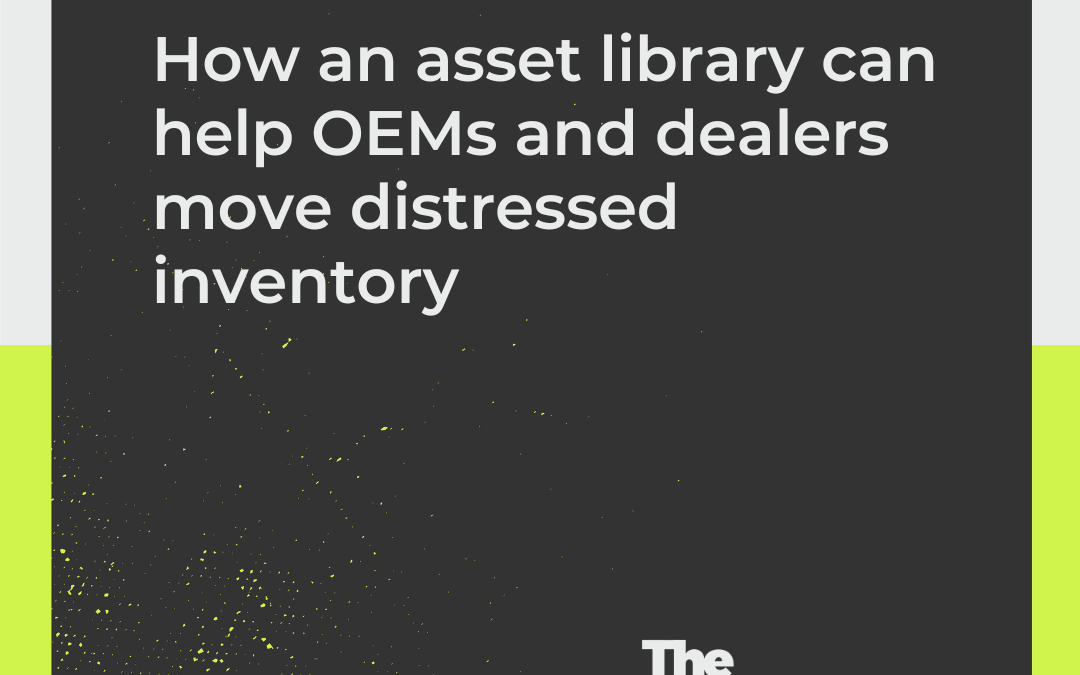How an Asset Library Can Help OEMs and Dealers Move Distressed Inventory
The Inventory
This Episode
Smarter inventory management leads to higher sales and faster reduction of distressed stock.
In this episode, Joe Mills and Dustin Clark, VP of Marketing Strategy at Element Three, discuss innovative ways for OEMs to improve inventory management. From using automation to handle excess stock to enhancing dealer relationships, they cover strategies about how to use information to move products more efficiently.
You’ll learn:
- How OEMs and dealers can sync systems for better inventory control
- Tech solutions to enhance inventory management
- Strategies to move distressed stock fast with targeted marketing
Episode Transcript
This transcript was generated with the help of AI and may contain some errors.
Dustin Clark [00:00:00]:
You might have dealer A, like, doesn’t want anything sitting on his lot longer than 100 days or a year or whatever, right? We only carry the last model year, and then we don’t want anything else versus another dealer that’s like, nah, I like the flexibility of having some older stuff because if I have somebody come in and they say, I can’t really afford that one. Well, I can mark down this one and get you. I can get you in the 2022. It’s just as good, right?
Joe Mills [00:00:27]:
Welcome to The Inventory, the show designed to give OEMs and dealers like you, actionable insight on channel marketing. From co-op programs to product portfolio design, we’ll arm you with the information you need to excel to enter new markets successfully, to build lasting OEM dealer relationships, and ultimately, to move more inventory. Let’s get started. Hey, everyone. Welcome to The Inventory. On today’s episode, we are going to talk about the relationship between assets and inventory management. Those assets could be product information, product photography, and sales cycle information, among others.
Joe Mills [00:01:01]:
And we’re going to talk about how to use that information to really help you move inventory more efficiently. Okay, Dustin, we were finishing up another show, and you brought up inventory and asset management. Can you connect those dots for me?
Dustin Clark [00:01:17]:
Yeah. So your asset library is a key component in being able to unlock inventory management. And this is not just for the OEM. This can be for the dealers.
Joe Mills [00:01:27]:
Right.
Dustin Clark [00:01:28]:
If you get your systems connected. I haven’t met an OEM yet that doesn’t know what products they sold to their dealers, so they know what’s sitting on a lot. If their dealers are reporting back sales, then they know what they have from a distressed inventory standpoint. We bought this a year ago, two years ago, three years ago. It’s been sitting out here since COVID, guys, what’s going on? Right? Or the thing that we’re all dealing with is we amped up production during COVID and then now it’s catching back up to us. So we’ve got some distressed inventory on the lines. The asset inventory that’s coming from the manufacturer matters hugely in this opportunity, because if it’s already sitting there and you know that the inventory is distressed on a lot. You have photo, you have dealer location, you know the model that’s sitting there. You can take your asset library and immediately put it in market through paid media based on the amount of distressed inventory that’s existing in a specific location.
Dustin Clark [00:02:24]:
Now, imagine if you’re a smart OEM and you’re taking these photos after production, like it’s coming off the lot before you deliver it to a dealer. You now have, let’s say you’re in boating or RVing or whatever, you have a vin based, a product Sku based photo that belongs to this vehicle. It’s going to this dealer. You can tell your dealer, hey, if you haven’t moved this through whatever the sales cycle is, let’s say it’s 270 days. At day 271, as your partner, were going to immediately turn on the inventory in your location for this. We’ve already got the photo, now we dont have to say, oh, lets go get marketing involved. Lets snap it again. Lets say what are we going to do, dealer, can you take a picture of this on the lot? It already exists.
Dustin Clark [00:03:06]:
So lets take that photo and when we cross that threshold of when are we getting nervous about this becoming distressed inventory, if that asset library is broken out and its deep, then you have so many options to be able to put something in market to help your dealer sell.
Joe Mills [00:03:21]:
Okay, so this already seems pretty actionable, but the one question I have is if you could take some of the list you just said, you mentioned, um, photography, you mentioned date of sale, you mentioned like the time period for when you get this, like when it becomes distressed inventory. What’s the data that I need to have? Not like ability to collect or be tracking? Cause honestly, all of it sounds like it’s already there. But what do I need to go find as the OEM in order to actually activate this in a, in a meaningful way?
Dustin Clark [00:03:50]:
Yeah, I mean, it’s, it’s, it’s model type, it’s location. Ideally it’s pricing, it’s having photography. It’s some model details so that you can automate like the dynamic details around it. This is the product name, this is a product description. Lots of that stuff already exists in an ERP system or something like that. But even if it doesn’t like put it in a spreadsheet, like the, the media platforms are super, super smart. We can automate those things. We do it all the time, but we can also use simpler methods to get it done.
Dustin Clark [00:04:20]:
The thing that’s the hard part of it is having the asset, usually the photography asset. The information is just text, right? We can type text. We can make that happen real, real quick.
Joe Mills [00:04:30]:
Is that the pushback that you get most of the time from the OE that we see? They’re like, I don’t have a good asset for it.
Dustin Clark [00:04:36]:
A lot of times it is, right? Yeah. It’s the photography. Sometimes it’s the, we don’t know what the distressed inventory is, but we’re seeing that less and less. It’s that they haven’t been able to put together to stitch together like, oh, asset plus product inventory in a, in a manner that’s available to get to an automate. Plus the inventory and location information, it’s, it’s, it’s. Sometimes it’s disparate, right. It’s in different places. Um, but connecting it can be automated.
Dustin Clark [00:05:05]:
That would ideally be, I mean, like, let’s take away the fear of ever having, you know, distressed stuff on a lot and not having an answer for our partners, right. We can take away that fear by automating it based on sales cycle and like, the distressed inventory age. But even if you can do that, you could still build a spreadsheet tomorrow that could go make this a reality for the locations that, you know, have that, or call up your dealers and say, what do you want to move? Yeah.
Joe Mills [00:05:32]:
There’s two other things that are interesting here. There’s the sales cycle, and there is the distressed inventory timeline. Let’s start at the second one. For distressed inventory, is there a recommendation? Let’s say that you release a model year every year. So let’s say every march you release your next set of products. So every 365 days, is it like one year -80 days? Is it one year minus a quarter? Is it actually more than one year before? Is there any commonality around when things become distressed?
Dustin Clark [00:06:08]:
That’s a really good question. I think that has a lot to do with the dealer and how they’re financing.
Joe Mills [00:06:13]:
Like, what’s, what’s their, what’s their F&I situation?
Dustin Clark [00:06:16]:
Yeah, what’s their F&I situation? What’s their floor plan? Some get nervous about different products at different times, right? Like I’ve heard some OEMs be like, well, this product’s got like a 600 day sales cycle. So I am real nervous about that one because we’re not there yet. But this one normally has a 200 day sales cycle and now I’ve got 40 sitting on six different lots that are at 300 days plus emergency. Right. And so again, the cool thing is if you can automate all this, you can set different parameters by model type or dealer sensitivity, right? You might have dealer A, like, doesn’t want anything sitting on as lot longer than 100 days or a year or whatever, right. We only carry the last model year and then we don’t want anything else versus another dealer thats like, nah, I like the flexibility of having some older stuff because if I have somebody come in and they say, I cant really afford that one. Well, I can mark down this one and get you, I can get you in the 2022. Its just as good.
Dustin Clark [00:07:13]:
Right. So some of that can be based on the fiat of the dealers and the models, but that flexibility is there via the automation to kind of set it up however you might want to do.
Joe Mills [00:07:23]:
Cool. Well, I think this also touches on something we’ve talked about prior, which is the connection point between the technology stacks, because you have to be able to close the loop on your sales in order to even know answers to what’s my sales cycle? How fast does this product move off the lot versus that product normally move off the lot? And if you don’t have those answers, it sounds like you’re stuck.
Dustin Clark [00:07:43]:
Yeah, totally. The risk here is if you didn’t have that closed loop back from a dealer CRM and you did something like this, where you automated it, they could have already moved the unit, and then it just, you didn’t get the notification yet, or you’re waiting for them to manually report it back in. But to me, that’s maybe a small risk. Like, I would still, I would encourage, I would use this as a carrot with my dealers to say, hey, if you’re giving me back this information, one of the promises that I’ll make to you is if I know what inventory is sitting on your line, I can help you promote it via these methods that, that’s, you know, again, whether that’s media, it could also be email. It can be, there’s different things you can do.
Joe Mills [00:08:19]:
You can do direct mail if, you know, I, if it’s a repeat buyer, you have a location.
Dustin Clark [00:08:23]:
Well, if it’s a high value product or they need some type of special incentive, right. When we talk about the four p’s of marketing, let’s talk about price, let’s talk about promotion. There’s some things that you could do where, again, right into your dealer agreements that, hey, once this receives, it’s past our sales cycle by this many days, we can automatically mark it down and figure out a way to move it for you.
Joe Mills [00:08:45]:
The last thing I’ll call out there is, you talked about automation a few times. This doesn’t have to be automated. And a lot of times, it likely is smarter to start with some manual management of this and then build yourself.
Dustin Clark [00:08:58]:
If I were in an OEM seats right now, and I’m thinking about this like, this probably is like, oh, my God, this is monumental. Pick a dealer, pick one and test it. Do a pilot. Say hey, for the next coming year. What’s your threshold of comfortability around distressed inventories? 150 days. Just making it up. Right? Dealer X, 150 days.
Dustin Clark [00:09:17]:
From now on, when we see a product go from 151 plus days, were going to pick two products, right? Just whatever. Just pick something, start it and test and see if it moves the needle. No bets are without risk, but this is something that you could test in a small market. Or again, go after a dealer that has a lot of distressed inventory and if it works and is effective, then you can let it ripple effect out like a drop in the pond. Right? We tried it. It worked great. Let’s extend it to the next series of dealers that have this problem.
Joe Mills [00:09:50]:
Awesome. Good stuff, Dustin.
Dustin Clark [00:09:52]:
Yeah, no problem.
Joe Mills [00:09:53]:
Element Three is a full-service marketing agency that bridges the gap between OEMs and their dealers. For more insights on how to go to market well in the dealer model, head to elementthree.com.
Sharing Expertise
What good is learning something if you don't pass it on? You can tap into what we know right now – from dealer programs to determining brand architecture – and you don't have to give us a thing.




